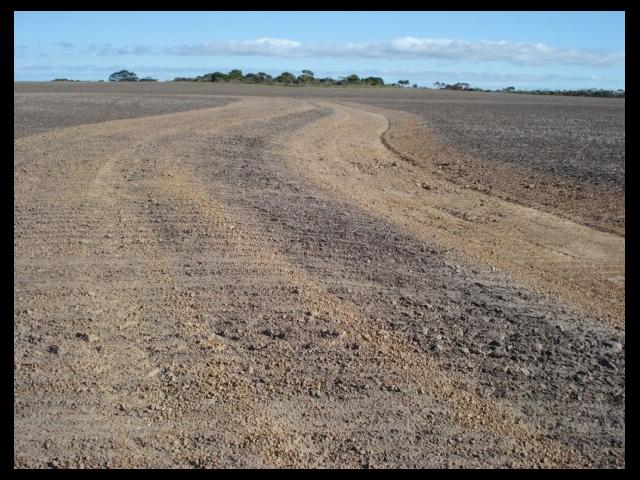Reduce water erosion risk with planned controlled traffic farming systems
The importance of surface water management to reduce the risk of water erosion associated with controlled traffic farming (CTF) was highlighted following widespread flooding across the grainbelt due to unseasonably heavy rain in February 2017.
Some areas received 300mm of rain over a few days, which is greater than a 1:100 year rainfall event.
Significant soil erosion was reported from a range of farming enterprises and systems, including but not exclusive to CTF systems.
The primary driver of erosion was the rainfall amount, distribution and intensity, with the majority of erosion occurring where water flows became concentrated.
Previous research has shown that the regular orientation of furrows and tracks in an up and downhill CTF system enables surface water to drain uniformly down the slope, reducing the risk of furrow overflows and erosion.
Surface water management measures may also be required to direct water safely, depending on soil and landscape characteristics and the property’s paddock layout.
It is important to minimise erosion risk of wheel tracks by filling in sunken or rutted tracks using commercial renovators that are available or versions that farmers have engineered.
When designing a CTF layout, farmers need to consider the slope of the land, length of run, catchment area and soil type.
These all contribute to the speed and erosive potential of the water flowing downslope.
Long runs, often the most efficient for machinery operations, may need surface water management structures to break up sloping land where gradients are greater than 1%.
This will also assist with reducing waterlogging or inundation in higher rainfall areas.
Broad based banks to divert water flow are compatible with CTF and are suitable for slopes with gradients up to 6%.
Broad based banks have a wide channel that allows machinery to drive through the drain and over the gentle bank .
The optimum length of run and bank spacing will depend on soil type, slope gradients and rainfall intensity.
Information on rainfall intensity for a specific location is available from the Bureau of Meterology website.

Banks must run water to a safe and stable waterway, which can be a constructed grassed waterway, or a naturally-vegetated creek or river.
Plant roots and organic matter in grassed waterways slow down water and reduce its erosive potential.
Managing the erosion of water flows by maintaining good stubble cover and catch drains along access tracks can prevent erosion and costly remediation.
It is important to integrate water management between paddocks and farms of a watershed, to safely dispose of excess water and reduce the severity of damage caused by flood events.
It is also critical to prevent water shedding from uncultivated areas, such as rocky outcrops and roads, to avoid excess water concentrating in wheel tracks, which are unable to channel large volumes of water.
Information to assist landholders develop an integrated surface water management plan includes:
- farm knowledge
- water flow path maps
- catchment accumulation models
- aerial photographs
- soil type maps and topographic data
- yield maps
- satellite imagery.
Some of this data can be accessed for free from the Maps and Data page on the Department of Primary Industry and Regional Development website while more information on CTF can be found at Developing a controlled traffic (tramline) farming system.
Further information
- Surface water management
- Manage Surface Water - Liebe Group
- Controlled Traffic Farming Case Studies, WA – GRDC
- Controlled Traffic Farming Technical Manual - NACC
The project, Minimising the impact of compaction on crop yield, is funded by GRDC.
For more infromation contact:
- Bindi Isbister, Development Officer, Geraldton on +61 (0)8 99568532
- Paul Galloway, Research Officer, Esperance on +61 (0)8 9083 1127
- John Simons, Research Officer, Esperance on +61 (0)8 908 1128.
